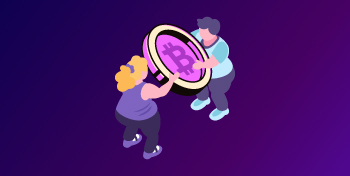Recently, Ethereum has been facing certain limitations, such as slow transactions, high fees, or slow implementation of the Proof-of-Stake consensus mechanism, etc. This provides an opportunity for the growth of a competitive environment that is trying to raplace the favorite.
Fight for the leadership of Crypto-blockchains
Ethereum hasn’t looked back since its launch in 2015. It is one of the pioneers of the revolutionary changes in smart contracts that have led to the mass adoption of blockchain technology in several business sectors.
Ethereum supports ERC-20 tokens that provide slightly better scalability and help developers build decentralized applications in the ecosystem. This is one of the reasons why the project has become one of the most reliable blockchain platforms in recent years.
Today, with the advent of more modernized blockchain platforms, Ethereum is facing serious competition. Let’s now take a look at some of the main alternatives to the Ethereum blockchain.
Best Alternatives to Ethereum

There are many alternatives available, and in previous articles we have repeatedly discussed in detail the various smart contract platforms for the blockchain application. So this time, we have included the most popular, competitive and best alternatives to Ethereum for smart contracts and Dapps in the list.
Tezos
Tezos is one of the most promising and developing networks in the world of cryptocurrencies. It is different from other blockchains and aims to give users full control.
After Ethereum, Tezos can be considered the most decentralized platform among other protocols. A minimum of 80% of all stack coins are required to reach consensus on adding a blockchain. The core code of Tezos is owned by a foundation, not a private organization, very similar to Ethereum and EOS.
Key features include:
- Tez or XTZ is the official token of the platform.
- Tezos does not support mining. Instead, users are rewarded by participating in the pos consensus algorithm.
- Tezos users have full control over the network and take part in making decisions that are deployed on the network.
- Users can make suggestions. If the offers are accepted, they can receive a reward.
- Decisions are made by collective vote.
Zilliqa
Zilliqa is the first public blockchain without access rights with a successful implementation of segmentation to achieve a high level of scalability up to 10 thousand. TPS. This is a fairly new technology in the network, which is a new-generation blockchain network operating on segmented network technology. It uses a hybrid form of the pow algorithm based on Practical Byzantine Fault Tolerance, or pbft. This not only increases scalability, but also improves network performance.
Advantages:
- Successful implementation of sharding.
- High throughput of up to 10 thousand transactions per second.
- Zilliqa is highly secure and has a unique consensus on Practical Byzantine Fault Tolerance (PBFT).
- The Ziliqa POW + PBFT algorithm requires much lower transaction fees.
Disadvantages:
- Due to the high bandwidth, a large amount of data will be required for storage.
- Zilliqa implements segmentation, but it is a transaction segment, not a state segment.
Ethereum Classic
Ethereum Classic (ETC) is the best alternative smart contract to Ethereum. Ethereum Classic was developed on the basis of a fork as a result of the DAO attack in 2017 on the Ethereum blockchain. It has all the features of the original version of Ethereum, but at a much lower price, and aims to provide more updated features in the future.
Ethereum Classic is completely different from Ethereum (ETH), and they should not be confused. Unlike ETH, the project does not cancel transactions. They support smart contracts and work on a Proof-of-Work (pow) consensus mechanism.
Currently, most companies operate on the Ethereum blockchain. To conduct their daily transactions, traders must pay with Ether. This is the reason that the price of ETH is about 23 times higher than Ethereum Classic. But with the growing popularity of ETC, the market scenario can change at any time, and the price of the asset may soon skyrocket.
Advantages:
- Traders now have the opportunity to save money by switching to Ethereum Classic from Ethereum. Ethereum Classic runs on the same blockchain protocol and is much cheaper. Thus, launching projects on Ethereum Classic can be more profitable for future business.
- It is believed that due to the growing popularity of ETC, the price of Ethereum Classic could rise dramatically as more and more investors and traders switch to Ethereum Classic.
Disadvantages:
- Ethereum Classic has not yet become popular in the business community. Most regular users trust ETH when conducting their transactions. They don’t want to use ETC for their business programs.
- Ethereum Classic works with pow or a proof-of-work consensus mechanism, while in Ethereum you can switch from pow to pos (proof-of-ownership), which is the main reason for its popularity.
- The Ethereum platform plans to introduce new features in the future, which may be a plus compared to ETC.
- The Classic competition between Ethereum and Ethereum may not benefit the business. Many loyal ETC users use Bitcoin and do not support Ethereum.
Cardano
Cardano is one of the first blockchain platforms developed on the basis of extensive scientific research. This new century blockchain network is the brainchild of Charles Hoskinson, who is, in fact, one of the developers of Ethereum.
Cardano is a public, open-source blockchain that can be modified and developed according to the needs of developers. The crypto project runs on the Ouroboros pos consensus algorithm, which provides greater scalability of the platform than Ethereum.
Advantages:
- It is aimed at providing greater scalability, compatibility, security and manageability compared to ETH.
- The platform is supported by a team of experienced engineers and consultants, most notably Charles Hoskinson, one of the co-founders of ETH.
- Developers and users can refer to the official document, which describes in detail all the technical details of the network.
- It offers more improved scalability.
Disadvantages:
- Cardano has not yet implemented all its features.
EOS
EOS claims to be the most scalable and feature-rich decentralized ecosystem in the cryptocurrency market today. It was launched in 2017 and is noted as one of the most profitable ICOs with a total amount of 1 billion.
The platform is suitable for developers, especially those who want to run their decentralized applications, and gives its users the full power of capabilities. Any changes that need to be made must go through a consensus vote of the platform’s users.
EOS runs on DPoS or a delegated share confirmation algorithm that protects them from DAO attacks, malware, and limits the penetration of corrupted dApps into the system.
Advantages:
- A fully scalable platform that is open to further updates and development.
- Dan Larimer, one of the EOS developers, is still working with the system.
- Currently, EOS has a maximum throughput of up to 4,000 transactions per second.
Disadvantages:
- EOS is similar to other cryptocurrencies and requires the addition of new features.
- It has not yet been widely adopted.
TRON
Founded in 2017, Tron is a decentralized blockchain platform that aims to bridge the gap between consumers and content creators by eliminating middlemen. TRON operates one of the largest blockchain networks and is a highly scalable platform. It is one of the most distributed platforms, but also the most centralized in terms of management. The main Tron code is owned by a private company, unlike Ethereum or Tezos.
Features:
- TRON can perform 2000 transactions per second, which is much higher than Ethereum.
- Smart contract with a high degree of scalability.
- Ability to run various dApps. TRON is compatible with an EVM or Ethereum virtual machine.
- The platform supports TRC-10 and TRC-20 coins.
- Integrated API.
- Supports decentralized exchanges.
NEO
NEO, commonly known as” China’s Ethereum, ” was first launched in China. NEO and Ethereum are very similar, and are a blockchain platform designed to host decentralized smart contracts and Dapps.
Supported by the Chinese government, NEO uses the delegated Byzantine Fault Tolerant consensus algorithm, while Ethereum is not supported by any government and is based on decentralization.
NEO can achieve a throughput of around 10,000 transactions per second (tps), whereas Ethereum currently only supports 15 TPS.
Advantages:
- High scalability.
- Multilingual platform.
- High TPS or transactions per second.
- Implements soft forks.
Disadvantages:
- Multiple root of the chain.
- Subject to the strict jurisdiction of the Chinese Government.
Conclusion
Summing up, we can safely say that the crypto industry does not stand still, but continues its rapid development. If not so long ago all the experts were saying that cryptocurrencies and blockchain are in their infancy, today there is hardly anyone who will say this. Blockchain technologies are rapidly developing, and some projects are being replaced by more innovative ones. But, it should be noted that Ethereum is not called the queen of the crypto just for nothing. It is still far from giving up the palm to someone else. But time will tell.


